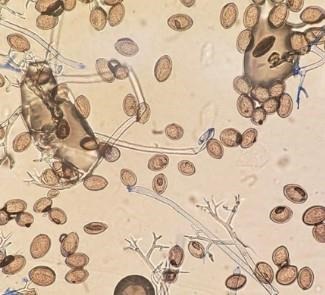
The pilot study, reported in the peer-reviewed journal Frontiers of Science, was led by Melha Mellata, associate professor, Department of Food Science and Human Nutrition, and Graham Redweik, a recent doctoral student in the Interdepartmental Microbiology Graduate Program at Iowa State, who is now at the University of Colorado-Boulder. The multidisciplinary collaborative Iowa State project team also included James Oliver, director, Virtual Reality Applications Center; Suzanne Millman, professor, Department of Veterinary Diagnostic and Production Animal Medicine; and Mark Lyte, professor, Department of Veterinary Microbiology and Preventative Medicine.
To conduct the study, the researchers displayed video projections of chickens in free-range environments. Scenes showed indoor facilities with access to an outdoor fenced scratch area and unfenced open prairie with grasses, shrubs and flowers. A group of 34 hens from commercial poultry flocks was exposed to the videos over five days on all four walls of their housing. The videos were tested during a high-risk period for stress -- 15 weeks after hatching, a stage when commercial layer hens are regularly moved from pullet to egg-laying facilities.
The visual-only recordings showed diverse groups of free-range chickens performing activities associated with positive poultry behaviors based on time of day, such as preening, perching, dust-bathing and nesting. Videos were not shown to a control group of the same size and age in the same type of housing.
After the treatment period, the researchers analyzed blood and tissues from the chickens, as well as samples of their intestinal microbiota. Chickens in the treatment group showed several beneficial changes compared to the control group. The differences included lower indicators of stress and an increased resistance to Avian Pathogenic E. coli bacteria that can cause sepsis and death in young birds.
“There are many challenges associated with free-range production environments for laying hens, including potential for additional injuries, disease and risks from predators. However, hens in free-range environments do tend to engage more often in positive, ‘normal’ behaviors that seem to enhance their overall health and immunity,” Mellata said. “It’s intriguing to think that even just showing hens free-range environments can stimulate similar immunological benefits.”
The idea for the study originated when Mellata attended a seminar on new uses of virtual reality in different fields presented by Oliver, with the Virtual Reality Applications Center.
“We need more research, but this suggests virtual reality could be a relatively simple tool to improve poultry health in confined environments and improve food safety,” Mellata said. “It could also be a relatively inexpensive way to reduce infections and the need for antibiotics in egg production.”
The team hopes to expand the research to conduct a similar study over a longer time, with more chickens and chickens at different stages, to see if the results can be replicated.
“Future research in collaboration with our partners in veterinary medicine is also needed to investigate the neurochemical mechanisms linking the visual stimuli to changes in the chickens’ intestines,” Mellata said.
Support for this research came from an Iowa State University Presidential Interdisciplinary Research Seed Grant.
Source : iastate.edu